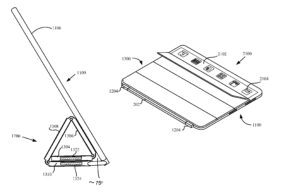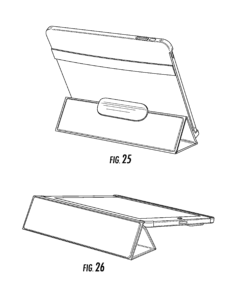미국 상표 출원 시, 가장 극복하기 어려운 거절사유가 바로 likelihood of confusion (LOC) 입니다.
번역하자면 혼동가능성, 즉 다른 출원/등록 상표와의 혼동 가능성 인데, 통상 LOC 거절에는 등록하려고 하는 상표와 유사한 기존 상표의 출원번호/등록번호가 인용됩니다.
출원번호만 인용된 경우
우선권(일반적으로 출원일이 더 빠른 출원이 우선함)을 가진 유사한 출원의 심사가 진행 중이라면 Notice of Suspension (심사중단통지)이 발행되고, 기존 상표의 심사가 완료될때까지 심사가 보류됩니다.
이 경우, 상표의 심사가 생각보다 오랜 기간 동안 중단 될 수 있습니다. 통상 상표 심사에는 8-12개월 걸린다고 하지만, 선행 상표 심사 과정에서 Non-Final Action 이 발행되거나 이에 대한 대응의견을 제출시한(통상 3개월이지만 3개월 연장 가능)을 다 쓰고 제출, 그리고 이에 대한 고려 후 Final Action 이 발행된 후에도 다시 한번 재심사청구가 가능한 점을 고려하면 2년 이상 심사가 지연될 수 있습니다.
따라서, Notice of Suspension 이 발행되면 마냥 기다리는 것이 아니고, 인용된 선행 출원의 심사 기록을 바탕으로 등록 가능성(거절사유의 번복 가능성), 소유권자의 미국 시장 진출 상황 등 을 조사하고, 필요한 경우 새로운 출원으로 방향을 틀거나 출원 내용을 변경해서 suspension 을 철회시키는 등의 조치를 취해야 합니다.
등록번호가 인용된 경우
유사한 등록이 존재한다면 Non-Final Action (흔히 office action 혹은 OA 라고 함) 이 발행되고, 이는 한국 특허청의 의견제출통지서와 마찬가지로 등록이 이러저러한 사유로 거절되었으니 이에 반하는 의견이 있으면 제출하라는 통지서 입니다.
여기에 등록번호가 인용되어 LOC가 언급되면 선행 등록상표와 등록하고자 하는 상표가 얼마나 비슷한지부터 시작해서, 품목에는 어떠한 연관성이 있고, 소비자가 상표를 어떻게 인식하고 구별할 지까지 다양한 각도에서 의견을 주고, 혹 이에 반하는 의견이 있으면 제출하라는 식의 통지서를 발행합니다.
심사관이 이미 위와 같이 다양한 시점에서 분석을 포함한 후이기 때문에, 실제로 심사관의 LOC로 인한 거절을 번복하도록 하려면, 심사관이 놓치거나 포함시키지 않은 요소를 추가하거나 지적해, 번복을 유도하는 것이 좋습니다.
LOC 거절 극복하기
기본적으로 두 상표가 “유사하다”라고 할때는 단순히 상표의 철자가 얼마나 똑같은지를 보는 것이 아니고, 표기 뿐만 아니라 발음과 인상을 함께 보게 됩니다. 다시말해 굉장히 주관적일 수 있다는 것이죠.
이 때문에 한번 심사관이 유사하다고 생각을 하면, 이러한 선입견을 바꾸기가 쉽지 않습니다. 따라서, 이례적으로 상표법이나 심사지침을 무시했거나, 잘못 이해했거나, 잘못 적용한 경우를 제외하면, 이미 심사관이 통지서에 포함시킨 해석과 조금 다른 해석을 제시하는 것 만으로는 설득이 어렵습니다.
새로운 증거 – 1. 다수의 유사한 상표 등록
사실 출원인으로서 가장 억울한 경우가, 유사한 상표가 이미 다수 등록되어 있는 경우입니다. 다른 사람들은 유사상표를 등록해서 잘만 쓰고 있는데 왜 나만 등록을 못하게 하나? 하는 생각이 들기 마련이죠. 이러한 많은 수의 유사상표 등록 하나의 증거가 될 수 있습니다.
헌데, 유사 상표가 단순히 등록되어 있다는 사실만으로 우리 상표를 등록해야 할 근거가 되지는 못합니다. 그러한 상표 등록이 잘못된 심사의 결과일 수도 있고, 등록 시점에서 품목 간의 연관성이 떨어졌던 상표들이 시장환경의 변화에 따라 연관성이 증가했을 수도 있기 때문이죠. 일례로 정기적으로 상표 분류체계에 대한 업데이트 시 동일한 품목의 국제분류가 바뀌는 경우가 있습니다. 이런 경우, 전혀 다른 국제분류에 있던 두개의 등록상표가 하나의 국제분류로 재분류 될 가능성도 있겠죠. 하지만 이런 경우에도 상표등록이 취소되지는 않습니다.
간단히 소개하자면, 비슷한 이름이나 디자인으로 다양한 상표가 등록되어 있을 경우, 그러한 이름이나 디자인은 하나의 브랜드의 정체성을 나타내기 보다는, 제품의 특징이나 성분 등을 뜻하거나 제품의 종류나 효과 등을 넌지시 알려주고 있다는 주장을 할 수 있습니다. 예를 들어, 스킨케어 상표 중에는 Glow 라는 단어가 들어간 상표가 많은데요. 피부의 광택을 뜻하는 이 단어는 광택이 나는 피부의 유행과 개인/중소 브랜드 화장품의 강세와 맞물려 많은 상표가 출원된 사례 입니다.
이런 경우, 보통은 LOC로 볼 수 있는 Glow 와 Glow Clinical* 이 공존할 수 있는 상황이 발생합니다.
*통상 한 단어가 등록(Glow®)이 되면 그 단어를 포함한 단어(Glow Clinical™, 6/17/2025년 기준 실질심사 통과 후 공시 진행 중)는 sub-brand 정도로 취급해 등록이 안됩니다. 예를 들자면, Nike 와 Nike Golf 를 통상 한 브랜드로 생각하는 경향이 있기 때문입니.
새로운 증거 – 2. 단어의 의미나 해석
같은 단어가 두 분야에서 전혀 다른 의미로 해석되는 경우가 있습니다. 또한 일반적으로 같은 뜻으로 사용되는 단어가 특정 분야에서는 각각 특수한 의미를 갖거나, 반대로 일반적으로는 전혀 다른 뜻으로 사용되는 단어를 통용해서 쓰는 경우도 있습니다.
실제로 상표심사시 말하는 혼동 가능성은 소비자의 혼동 가능성, 그 중에서도 특정 품목/서비스의 소비자의 혼동 가능성을 의미합니다. 즉, 상표를 등록했거나 등록하려는 품목/서비스를 실제 구입하고 이용하는 소비자의 인식이 중요하다는 거죠.
따라서, 심사관이 일반적으로 구매하고 사용하는 제품이 아닌, 특수한 상품이나 서비스의 경우에는 내가 알고 있는 것을 심사관도 알고 있다고 단정하지 말고, 해당 업계의 전문가나 관계자의 증언이나 전문자료, 출판물 등을 제출하면 도움이 됩니다.
새로운 증거 – 3. 출원 서류의 정정
새로운 증거라고 하기는 어렵지만, 출원 시 포함시켰던 품목을 삭제하거나, disclaimer 를 추가하는 등 심사대상 자체를 변경하는 방법도 고려해 봐야 합니다.
통상 출원 시에 없던 내용을 추가하거나 상표 자체를 변경하는 것은 불가하지만, 있던 내용을 빼거나 상표의 일부에 대한 권리 주장을 포기(disclaimer)하는 등의 변경은 허용됩니다.
결국 심사기준이나 해석, 적용을 바꾸기는 어려우니, 아예 심사대상을 바꾸는 접근입니다. 이런 경우 원칙적으로는 새롭게 심사를 해야겠지만, 사람이 하는 일이라 그렇지 않겠죠. 따라서, 단순히 출원변경(amendment)을 제출하는데서 끝내서는 안되고, 그러한 변경이 왜 상표등록을 가능케 하는지 자세히 설명해서 함께 제출해야 좋습니다.
모든 OA 대응 시 공통사항
Response to office action 양식을 제출할 때, 자주 문제가 생기는 부분이 “모든 거절사유”에 대한 응답을 하지 않는 경우입니다.
SUMMARY OF ISSUES:
- Search results advisory: prior-filed applications may pose bar to registration
- Section 2(d) refusal – likelihood of confusion
- Identification of goods – clarification required
- Email address required
- U.S. counsel required
모든 OA 에는 위와 같은 요약이 포함되어 있고, 위의 예를 잘 살펴보면 총 5가지 사유가 있음을 알 수 있습니다.
첫번째 사유 advisory 는 유사 출원이 발견되었다는 내용입니다. 유사 출원이 있으면 통상 Notice of Suspension 을 하겠지만, 여기서는 실제 기존 등록에 의거한 두번째 Section 2(d) 거절 사유도 있기 때문에, 심사를 보류하지 않고 바로 거절을 냈습니다.
이렇게 advisory라고 명기하는 이유는 이는 반드시 응답을 해야하는 거절사유에 해당하지 않기 때문입니다. 다시 말해, 그 외의 4가지 사유는 반드시 서면으로 응답을 해야 상표가 출원포기 처리 되지 않습니다.
대응기한
일단 OA가 발행되면, 대응기한 안에 서면으로 응답을 제출해야 합니다.
기본적으로 OA가 발행된 날짜(issue date)로 부터 3개월이 주어지고, 필요 시 3개월 연장 신청할 수 있습니다. 이 기한을 지키지 않으면 상표는 출원포기(abandonment) 처리 되고, 출원날짜에 따라 획득한 우선권을 상실할 수 있으니 주의가 필요합니다.
물론 청원(petition)을 통해 부활(revive)시키는 제도가 마련되어 있지만, 우편발송 사고 등 고의가 아닌 기한미준수일 경우를 대비한 제도이고, 이 또한 가능한 시일이 한정되어 있으며, 추가적인 비용 또한 발생하니 대응기한을 꼭 체크하고 이에 맞추어 대응하셔야 합니다.
맺음말
아무래도 OA가 나면 서면으로 대응이 필요하기 때문에 변호사에게 맡기는 경우가 많지만, 요즘은 AI Chatbot의 도움을 받아 직접 OA 대응을 하시는 경우도 적지 않아 글을 써봅니다.
기본적으로 AI Chatbot 은 적절한 prompt 를 주지 않으면 가장 보편적이고 핵심적인 내용을 잘 정리해서 알려주기 때문에, 좋은 prompt를 입력해야 좋은 결과를 얻을 수 있습니다.
“이런 OA를 받았는데 어떻게 대응하면 좋을까?” 정도의 prompt 로 작성된 응답서면은 심사관이 1차거절 시 명백한 실수를 하지 않았다면, 거절사유를 극복할 가능성이 거의 없다고 생각하시면 됩니다. 그도 그럴것이, 심사관의 실수했거나 미처 생각지 못한 부분은 당연히 OA 내용에도 없으므로 AI Chatbot 에게 전달이 되지 않겠죠.
결과론적으로 AI는 대략적인 내용을 파악할 때 사용하시고, 그런 내용들을 바탕으로 어떤 새로운 증거들을 제시할 수 있을 지 깊히 생각해 볼 필요가 있습니다. 물론 이 과정에서도 AI의 도움을 받을 수 있겠죠. 그런 후에 자신만의 논리나 취지에 맞게끔 문서를 작성할 때에도 마찬가지로 AI 의 도움을 받을 수 있지만, 아무래도 논리를 풀어가는 스타일이나 문체가 심사관이나 변호사들이 익숙한 방식과는 조금 달라서 아무래도 이질감이 발생할 수 있으니 주의 바랍니다.



